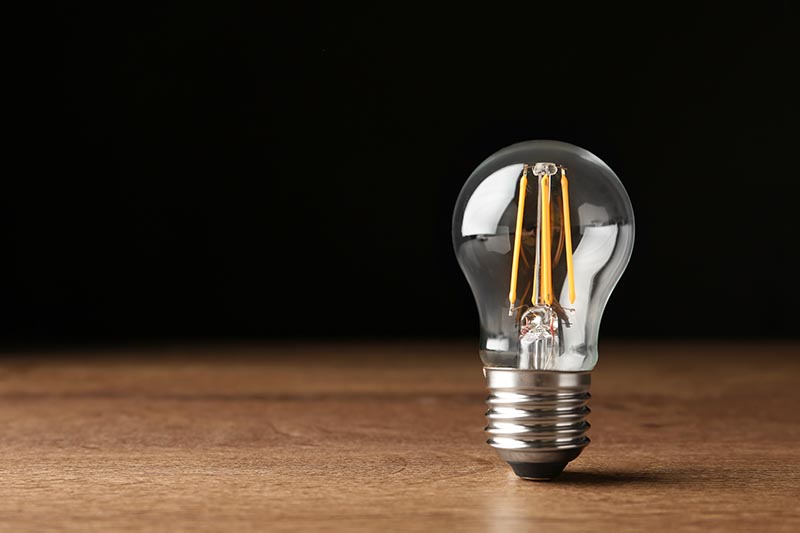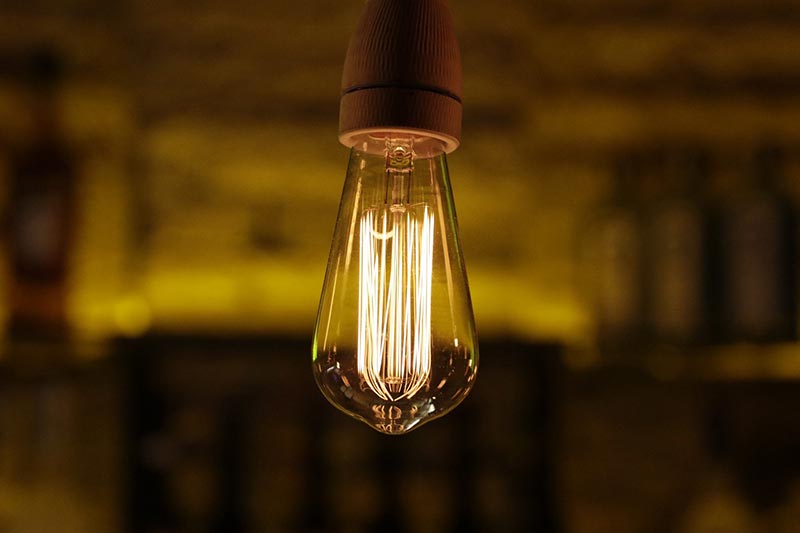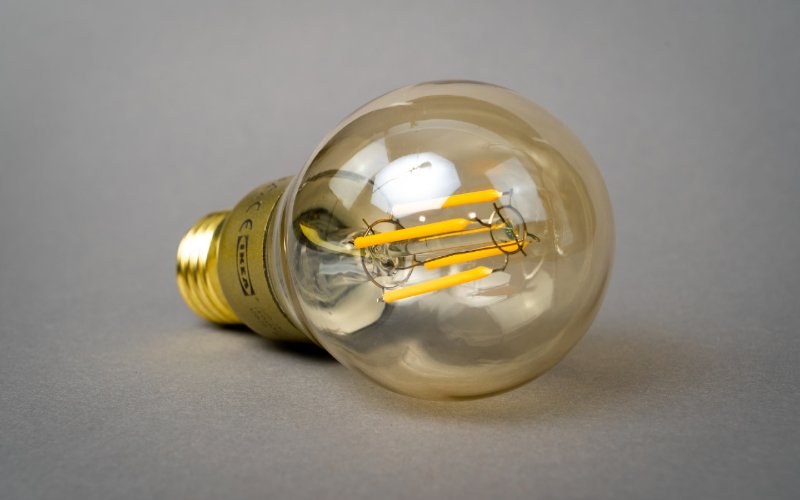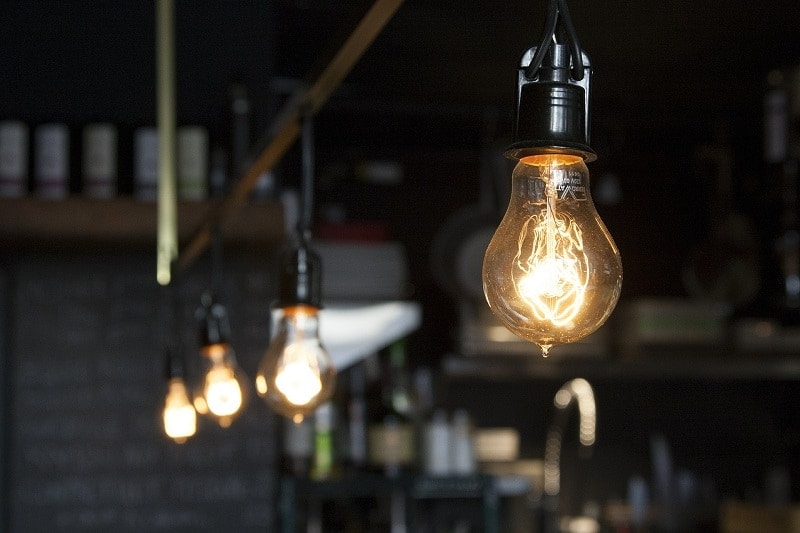Who Invented the Light Bulb? (History of the Light Bulb)
-
Pete Ortiz
- Last updated:

Light bulbs—it’s hard to imagine the modern world without them. Cheap, safe, and with a decent lifespan, they bring light into our lives, literally. That wasn’t always the case, though. This game-changing invention has only been around for 150+ years. The big question is—who’s the man responsible for illuminating the world? Thomas Edison is largely credited for inventing the light bulb.
However, it was Joseph Swan who built the very-first incandescent lamp. More importantly, none of that would’ve been possible without the immense contributions of Humphry Davy, Hermann Sprengel, and many other gifted scientists. And it all started back in 1802. So, join us, and let’s learn the amazing history of light bulbs!
The Origins: Early-18th Century
At the beginning of the 18th century, oil lamps and candles were the only means of illumination. While oil and wax did, indeed, light the way for our ancestors, they weren’t at all safe or long-lasting. Furthermore, you couldn’t light a lamp without it producing smoke and bad odors. Regular folks used tallow candles and animal fat to defeat the dark. Even the most expensive beeswax or spermaceti candles 1 were a mess to handle.

The First-Ever Electric Light: 1802
It was Sir Humphry Davy, a physician from the UK, who made the first breakthrough. In 1802, he passed an electric current through a thin platinum strip and generated light. His invention was the predecessor of modern-day light bulbs. The current wasn’t strong, and the glow didn’t last, but nine years later, in 1809, Davy built a carbon arc lamp.
He brought it to the Royal Institute of London. To make the light stronger, the British pioneer used a battery to power up a pair of wires and a piece of carbon. Unfortunately, while his invention did leave a lasting invention, the lamp faded out too quickly for it to be a commercially successful project.
The First Patent and Vacuum Pump: 1841–1865
Almost forty years later, Frederick de Moleyns was granted the very first patent for an incandescent light bulb. The concept wasn’t very successful, however: the bulb was heating up way too quickly; the air trapped inside of the glass was another design flaw. Just like Davy’s carbon arc lamp, the Moleyns bulb was too risky and expensive to be considered a commercial product.
It took Hermann Sprengel, a gifted chemist from Germany, 24 years to turn the tide around. In 1965, he built a mercury vacuum pump that could remove all the air from the glass. As a result, the filament lasted for a lot longer, and there was no blackening of the bulb. Today, we know this invention as the Sprengel Pump.

Pavel Yablochkovs’ Arc Lamp: 1875
English and German scientists weren’t the only ones working on electrified lamps. The Russian Empire had Pavel Yablochkov, a talented engineer, who’s credited for developing the arc lamp. Marketed around the world as the Yablochkov Candle, his device lasted longer than the Davy and Moleyns bulbs. He built the lamp in 1875 and revealed it three years later in Paris.
Carbon rods did a great job of extending the battery’s life cycle, and when the Russian inventor lit up 64 candles, the demonstration turned into a big success. And that’s how the French capital got its name, the “City of Lights”. Soon after that, arc lamps became the most popular lamps in many European and American cities.
Joseph Swan’s Carbonized Paper Filaments: 1878
In 1878, the same year when Yablochkov made headlines with the Paris exhibition, Sir Joseph Swan, a visionary chemist from England, received a patent for incandescent light bulbs. He filled the globe with nitrogen while the conductor was crafted from carbon. The use of radiators made the conductor steady and stable, keeping the light on for a long time.
This revolutionary lamp was presented to the world in 1879. Unfortunately, while the lamp did work, it wasn’t at all reliable. The reason: Swan didn’t have a vacuum pump or a dependable electric source, which meant his creation was equally expensive, unstable, and a pain to run.

The Edison Bulbs: 1879
In 1874, Henry Woodward and Mathew Evans patented an incandescent bulb with a carbon filament. But, while their creation had immense potential, the light bulbs didn’t do well in the States or Canada. As a result, they sold them and the patent to Thomas Edison. The deal took place in 1879. That same year, on New Year’s Eve, Edison showed his incandescent light bulb to the public.
His team figured out that thin filaments were the key to a sustained light bulb. A year later, they built a bamboo filament that lasted for 1,200 hours! In 1880, he founded a company that focused on perfecting the concept, Edison Electric, and received his own patent. In 1881, Swan established his own business—the Swan Electric Light Company.
A Feud Turned Into a Merger: 1883
Edison managed to turn his lamps into a profitable business. In the late 19th century, representatives of the company were attending trade shows and exhibiting incandescent light bulbs to the public with a clear intention of making Edison the “face” of this new technology. So, who was the first person to gift the world with a working incandescent lamp?
Technically, it was Swan because he built it sooner. Edison, in turn, perfected it. That’s why in 1883, both men filed lawsuits against each other. Swan came out as the winner, and eventually, the two great minds decided to join forces, founding a new company, Ediswan. Swan was brought out of the company relatively soon, though.

Tungsten Filaments: a 1910 Breakthrough
For decades, the Ediswan light bulbs dominated the market until Mr. William Coolidge, a US-based chemist, decided to use tungsten instead of carbon filaments. That made the bulbs brighter, longer-lasting, and more reliable. Two years later, Irving Langmuir added nitrogen to the bulb for extra durability. In 1925, Marvin Pipkin, a fellow American inventor, managed to keep the glare to a minimum and reduce light output losses.
Halogens and CFLs: 1959–1980s
In 1959, the world saw the first halogen bulbs. The General Electric invention had a longer lifespan (up to 1,500 hours) and required 15% less energy to run. This is important: fluorescent lamps have been around since the late 1930s, but they were mostly used in industrial factories. That all changed during the 1970s oil crisis.
In 1976, General Electric presented the compact fluorescent light bulb (known commonly as CFL), designed and engineered by Edward Hammer. CFLs were expensive to manufacture, and GE didn’t stick with this technology. Other companies put their trust in Hammer’s invention. The first commercial-use fluorescent light bulbs arrived in the mid-1980s.
The LED Era: 1961–2000 and Beyond
The first LEDs were made back in 1961 by James Biard and Gary Pittman. A year later, Nick Holonyak created a red LED diode. In the late 1970s, LEDs were used as indicator lights in calculators and other devices. In 1993, Shuji Nakamura, a Japanese-born American engineer, came up with a blue LED. And, since the red, yellow, and violet didoes were already discovered, in the 2000s, full-fledged LED light bulbs hit the market. The rest is history!
LEDs, CFLs, and HIDs: What’s the Difference?
There are five types of light bulbs on the market. Their service life, efficiency, brightness, and cost of operation vary greatly. So, if you’re planning on replacing the old, dimmed bulbs in your house but aren’t 100% sure which one(s) to buy, this guide will help make the right choice:
- Incandescent bulbs. These lights have been around for more than 100 years, and they’re still in use, despite the rapid decline in popularity. The manufacturing process is fairly simple, and that’s why incandescent bulbs are relatively cheap. Energy efficiency leaves a lot to be desired, though; so does the lifespan (1–2 years).
- Halogen bulbs. The next step in the evolution of lights, halogen bulbs use 20–30% less energy than incandescent bulbs. Another big pro is their high resistance to heat. Overheating can be an issue, though. Halogen lights last for 1–2 years and are mostly used in trucks and SUVs and as low-voltage lights.
- Fluorescent bulbs. Commonly known as CFL lights, fluorescent bulbs have decent coverage and are even more efficient than incandescent bulbs (70–75%). However, they usually dim/fade out in 2–3 years (but can serve for up to 8–10 years). These lights are hard to dispose of.
- HID light bulbs. Often called Xenon lights, High-Intensity Discharge bulbs are much better than halogens. The beam cast by HIDs is wider and reaches farther. The biggest con is the fragile structure. On average, HIDs last for 2,000–3,000 Common uses include streetlights, warehouses, and car lights.
- LED bulbs. Light Emitting Diodes are vastly superior to all the previous inventions. A single LED bulb can last for up to 50,000 On top of that, LEDs are much brighter (80–100 lumens per watt versus 16–24 with halogen lights) and 85% less power-hungry. The slightly steep price is the only downside.
 Conclusion
Conclusion
Once you learn the history of light bulbs, you’ll never look at them the same. While they might not look the part, and we don’t usually give them much praise, light bulbs have changed the world. By allowing mankind to work during late hours, affordable lighting single-handedly boosted the economy, created new careers, and made our lives easier and safer.
And we can’t give all the credit to Edison, Swan, or Yablochkov. It was a collective effort, one that took more than 200 years to accomplish. Thanks to their incredible contributions, we now have LED lights that serve for over 50,000 hours. So, go ahead and turn on your night lamp or chandelier, and let there be light!
Featured Image Credit: New Africa, Shutterstock
Contents



